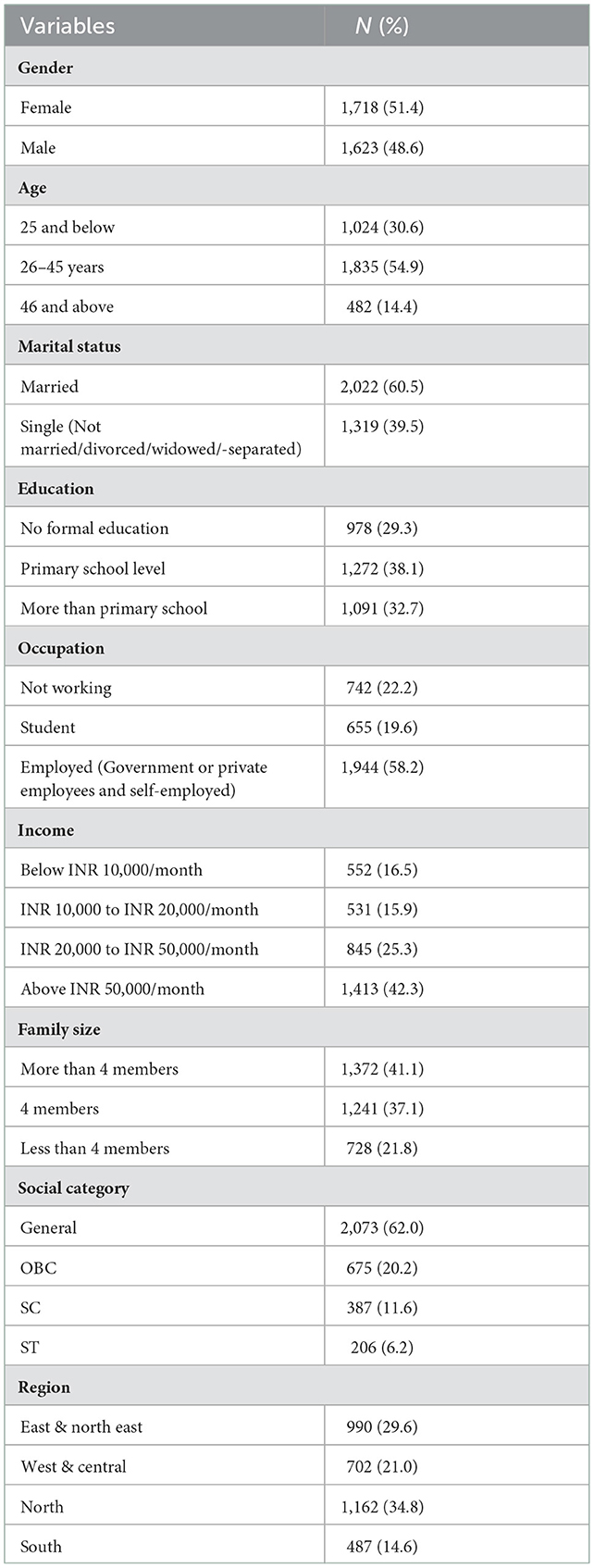An Erratum on
Sociodemographic determinants of willingness and extent to pay for COVID-19 vaccine in India
by Kiran, T., Junaid, K. P., Sharma, D., Jain, L., Vij, J., Satapathy, P., Chakrapani, V., Patro, B. K., Kar, S. S., Singh, R., Pala, S., Bali, S., Rustagi, N., Goel, K., Sankhe, L., Modi, B., Gupta, M., Aggarwal, A. K., Rajagopal, V., and Padhi, B. K. (2022). Front. Public Health 10:870880. doi: 10.3389/fpubh.2022.870880
Due to a production error, there was a mistake in the formatting of Table 1 as published. The corrected Table 1 appears below.
Due to a production error, the total number of participants in the study was erroneously reported as 3,371 on two occasions.
Corrections have been made to the Abstract, “Results” subsection, paragraph 3, and to the Results section, “Willingness to pay and sociodemographic factors” subsection, paragraph 16, in which this figure was corrected to 3,341 as follows:
Results: Out of 3,341 participants, 68% (n = 2,271) were willingness to pay for COVID-19 vaccine. Results showed significantly higher odds for willingness to pay among participants who were single [adjusted odds ratio (aOR) = 1.394, p < 0.01] and having a family size of 4 members (aOR = 1.346, p < 0.01). The adjusted odds ratio sizably increased from 1.396 for participants whose monthly income was between INR 10,000 and 20,000/month to 2.240 for participants whose monthly income was above INR 50,000/month. Further, out of 2,271 of those participants who were willingness to pay for COVID-19 vaccine, majority (n = 1,246, 54.9%) of participants were willingness to pay below 50% of COVID-19 vaccine cost. This study found that those who are single (aOR = 0.688, p < 0.01), having an income between INR 20,000 and 50,000/month (aOR = 0.686, p < 0.05), and those who belonged to socially disadvantaged category (aOR = 0.450, p < 0.01) were estimated to have significantly lower odds of willingness to pay more than 50% of COVID-19 vaccine cost.
Results
Willingness to pay and sociodemographic factors
Table 1 presents the details of sociodemographic characteristics of the participants and proportion of willingness to pay for COVID-19 vaccine. Out of 3,341 participants, 51.4% (n = 1,718) were females. Majority of the participants (n = 1,835, 54.6%) are aged between 26 and 45 years and were reported to be married (n = 2,022, 60.5%). A large proportion (n = 1,272, 38.1%) of participants were educated up to primary school level, while 29.3% (n = 978) of participants were lacked formal education. Around 32.7% (n = 1,091) of participants were educated more than primary school level. Participants who were working (government or private employees and selfemployed) recorded the highest proportion of about 58.2% (n = 1,944) as compared to 22.2% (n = 742) of participants who were not working and 19.6% (n = 655) who were students. A considerable number of the participants (n = 1,413, 42.3%) reported having monthly income “above INR 50,000,” while 16.5% (n = 552) of the participants was having a monthly income below INR 10,000. Looking at the family size, 41.1% (n = 1,372) of the participants reported a family size of “more than 4 members.” Majority of the participants (62%, n = 2,073) belonged to general category, whereas socially disadvantaged categories, namely, Other Backward Class (OBC), Scheduled Caste (SC), and Scheduled Tribes (STs) recorded a proportion of 20.2 (n = 675), 11.6 (n = 387), and 6.2% (n = 206), respectively. Of the total participants, North region of the country recorded the highest proportion of 34.8% (n = 1,162), whereas the South region of the country recorded the least proportion of 14.6% (n = 487).
The publisher apologizes for this mistake. The original version of this article has been updated.
Keywords: COVID-19, vaccine, willingness to pay, sociodemographic factors, India
Citation: Frontiers Production Office (2023) Erratum: Sociodemographic determinants of willingness and extent to pay for COVID-19 vaccine in India. Front. Public Health 10:1124119. doi: 10.3389/fpubh.2022.1124119
Received: 14 December 2022; Accepted: 14 December 2022;
Published: 04 January 2023.
Approved by:
Frontiers Editorial Office, Frontiers Media SA, SwitzerlandCopyright © 2023 Frontiers Production Office. This is an open-access article distributed under the terms of the Creative Commons Attribution License (CC BY). The use, distribution or reproduction in other forums is permitted, provided the original author(s) and the copyright owner(s) are credited and that the original publication in this journal is cited, in accordance with accepted academic practice. No use, distribution or reproduction is permitted which does not comply with these terms.
*Correspondence: Frontiers Production Office,  cHJvZHVjdGlvbi5vZmZpY2VAZnJvbnRpZXJzaW4ub3Jn
cHJvZHVjdGlvbi5vZmZpY2VAZnJvbnRpZXJzaW4ub3Jn
 Frontiers Production Office
Frontiers Production Office